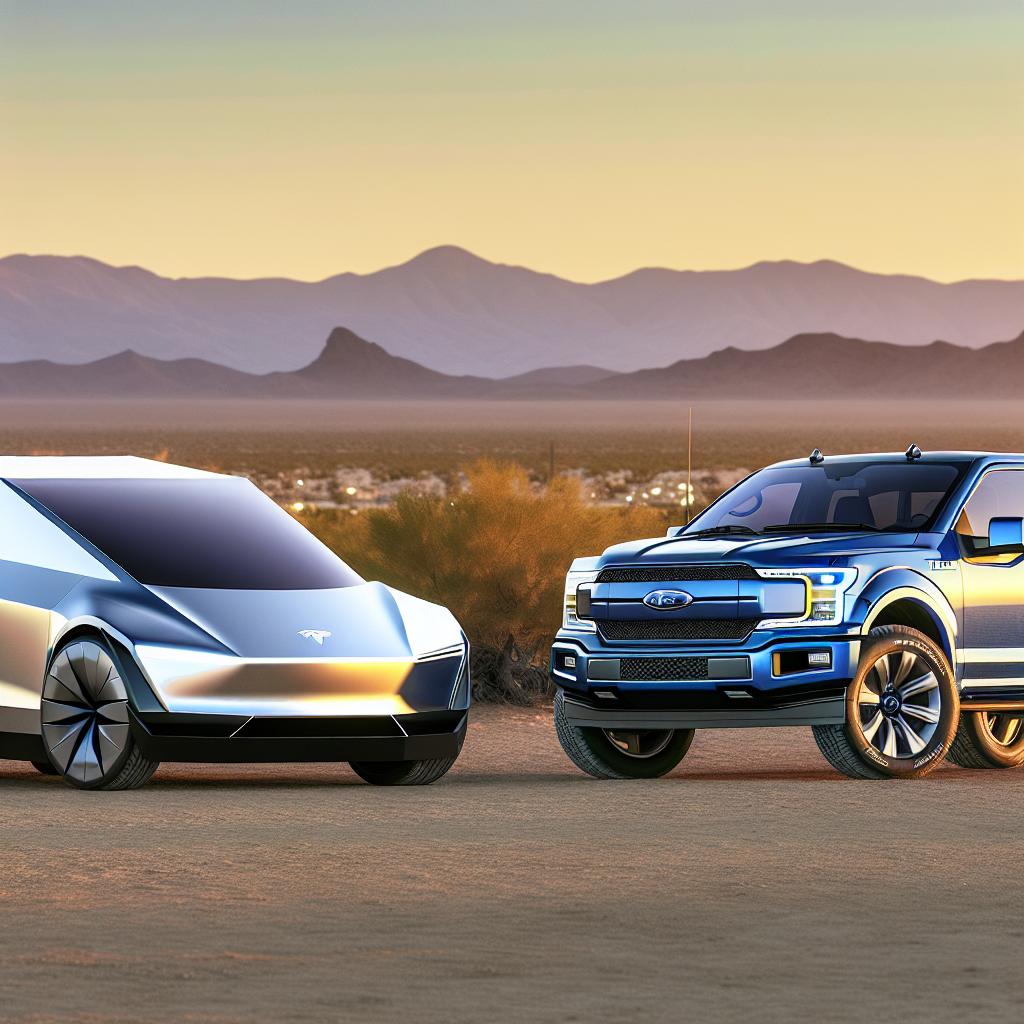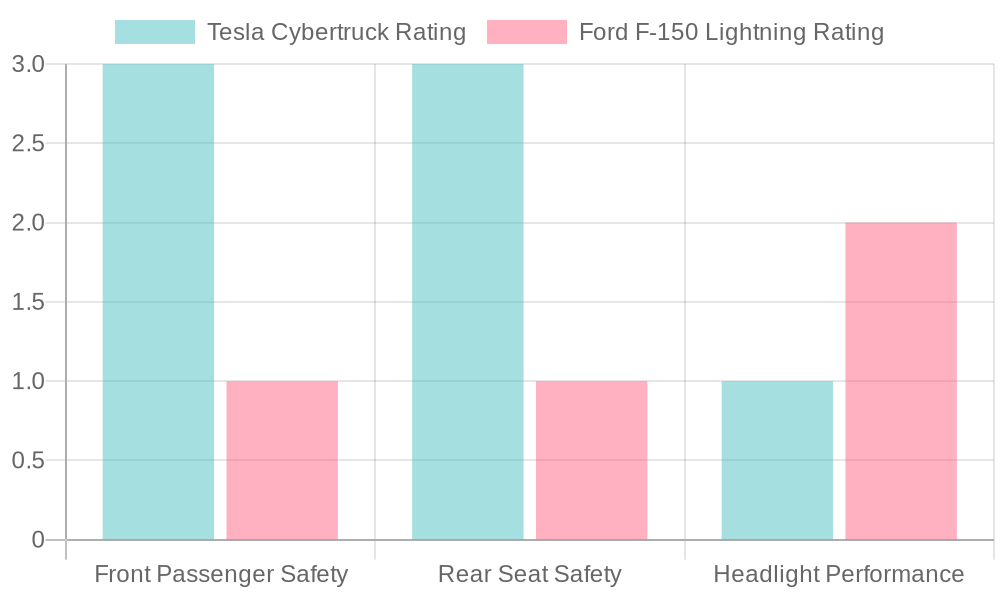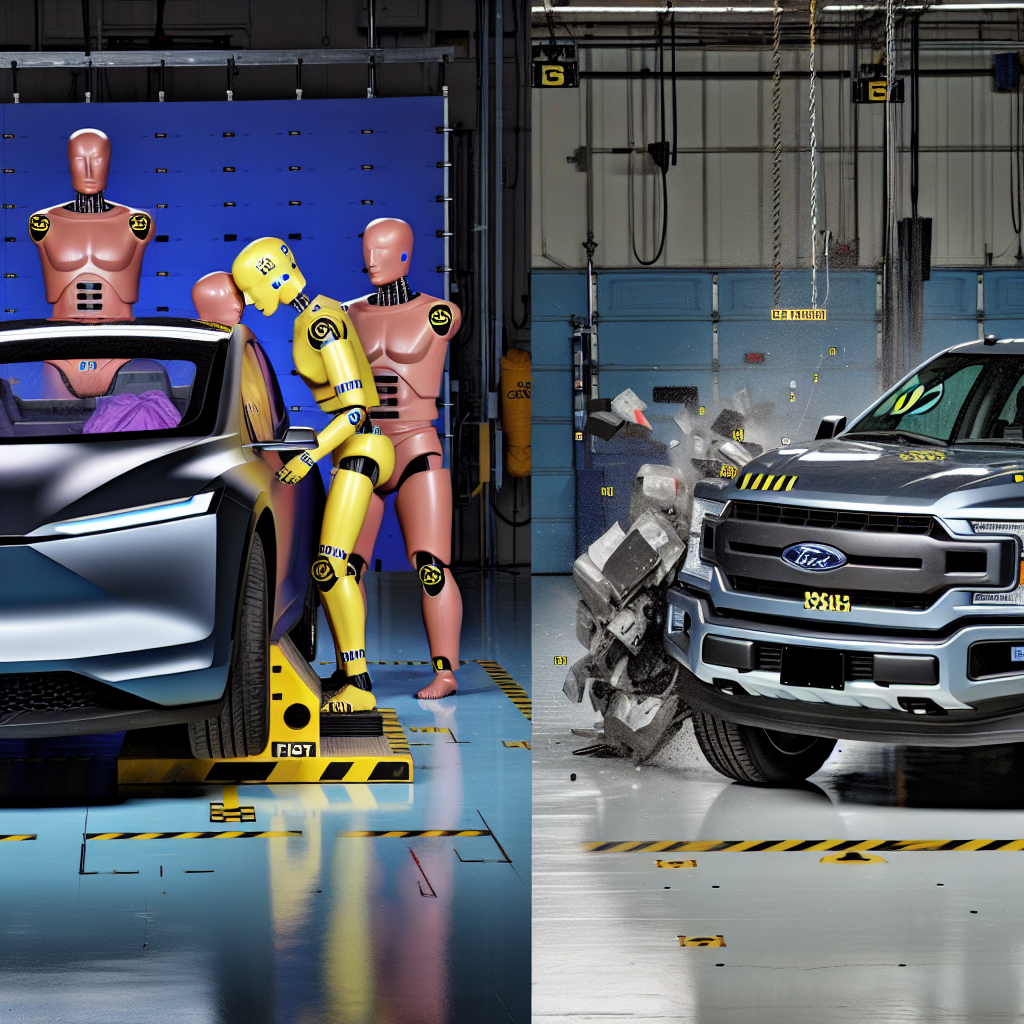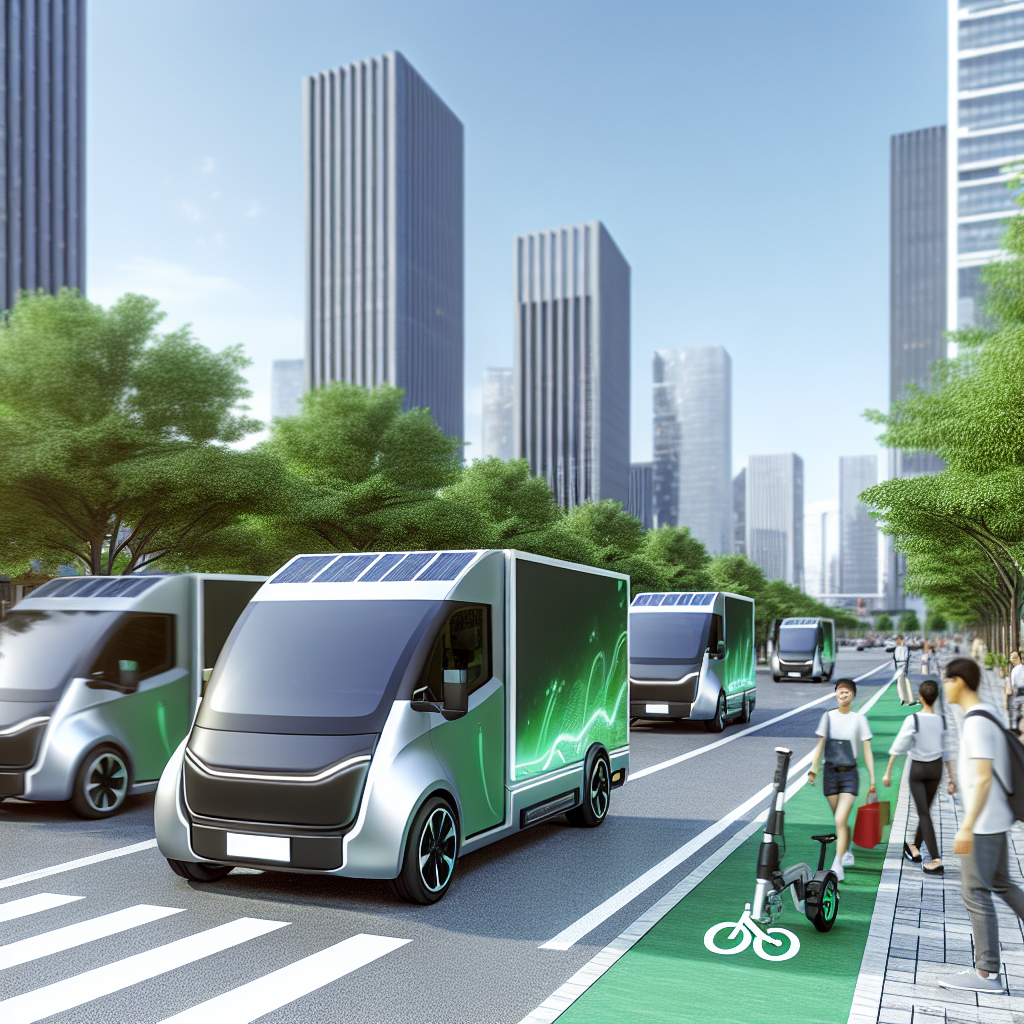In the ever-evolving landscape of automotive engineering, safety remains a paramount concern, particularly in the realm of trucks where robustness and reliability are expected. As the demand for electric vehicles (EVs) continues to surge, the significance of crash test results has grown, especially for standout models like the Tesla Cybertruck and the Ford F-150 Lightning.
The Insurance Institute for Highway Safety (IIHS) recently conducted extensive evaluations on these two electric trucks, shedding light on their safety performances in various crash scenarios. With a growing interest from consumers in understanding how these vehicles’ safety standards hold up against traditional trucks, these crash test results not only inform potential buyers but also reinforce the importance of prioritizing safety—including aspects like EV safety and child seat anchor compliance—in the transition to sustainable vehicles.
As we delve into the specifics of these crash tests, we aim to provide an analytical overview of how the Tesla Cybertruck and Ford F-150 Lightning measure up in real-world safety considerations, serving as crucial information for truck enthusiasts and families alike.
| Safety Aspect | Tesla Cybertruck | Ford F-150 Lightning |
|---|---|---|
| Front Passenger Safety | Good | Poor |
| Rear Seat Safety | Moderate | Poor |
| Headlight Performance | Poor | Acceptable |
| Overall NHTSA Rating | Five Stars | Five Stars |
| Front Crash Test (Driver) | Five Stars | Four Stars |
| Front Crash Test (Passenger) | Four Stars | Four Stars |
| Side Crash Test (Front) | Five Stars | Five Stars |
| Side Crash Test (Rear) | Five Stars | Five Stars |
| Rollover Resistance | Four Stars (12.4% risk) | Four Stars (<15% risk) |
| LATCH Ease of Use | Acceptable | Marginal |

The Insurance Institute for Highway Safety (IIHS) conducts comprehensive evaluations to assess vehicle safety, focusing on crashworthiness and crash avoidance. Key components of their evaluation process include the moderate overlap frontal test and the assessment of automatic emergency braking (AEB) systems.
Moderate Overlap Frontal Test:
Introduced in 1995, the moderate overlap frontal test simulates a collision where 40% of the vehicle’s front end collides with a deformable barrier at 40 mph. This test aims to replicate real-world frontal crashes involving partial front-end engagement. In 2023, IIHS updated this test to enhance rear-seat occupant protection. The revised protocol includes a second dummy, representing a 12-year-old child, seated behind the driver. This addition emphasizes evaluating the safety of rear-seat passengers, addressing a growing concern in vehicle safety. [learn.xsensor.com]
Automatic Emergency Braking (AEB) Evaluation:
IIHS assesses AEB systems under its front crash prevention tests, which are divided into vehicle-to-vehicle and vehicle-to-pedestrian categories. These evaluations measure a vehicle’s ability to avoid or mitigate collisions at speeds of 12 mph and 25 mph. Vehicles are rated as “Superior,” “Advanced,” or “Basic” based on their performance. In 2024, IIHS updated its pedestrian front crash prevention evaluation to include both daylight and nighttime scenarios, reflecting the importance of AEB performance in various lighting conditions. [iihs.org]
Through these rigorous evaluations, IIHS aims to provide consumers with critical information on vehicle safety and encourage manufacturers to enhance protective measures for all occupants.
Crashworthiness Ratings of Tesla Cybertruck and Ford F-150 Lightning
The latest crashworthiness evaluations conducted by the Insurance Institute for Highway Safety (IIHS) provide valuable insights into the safety performance of the 2025 Tesla Cybertruck and Ford F-150 Lightning. Both vehicles were subjected to comprehensive testing that focused on essential safety aspects, with varying outcomes in crucial categories such as front passenger safety and rear seat safety.
Tesla Cybertruck
The Tesla Cybertruck has demonstrated strong performance in crashworthiness, achieving notable ratings:
- Moderate Overlap Front Test: Rated “Good” for front passenger safety, indicating effective protection in frontal collisions. The Cybertruck also excelled in rear safety evaluations with the rear seat dummy showing proper positioning of the shoulder and lap belts, although some risk of injury was noted, especially for chest impacts.
- Rear Seat Safety: The Cybertruck received an overall “Acceptable” rating; however, its seat belt reminder system was marked as “Marginal” for being too brief, which may affect compliance.
- Headlight Performance: Despite its overall good ratings, the Cybertruck’s headlights faltered with a “Poor” rating due to excessive glare affecting visibility for others.
- Front Crash Prevention: The Cybertruck earned a “Good” rating for its pedestrian detection, showcasing its advanced safety features in avoiding collisions.
Ford F-150 Lightning
In contrast, the Ford F-150 Lightning exhibited some concerning results in its crashworthiness tests:
- Moderate Overlap Front Test: This model received a “Poor” rating overall, indicating a significant risk of injury for rear seat passengers. While driver protection was rated “Good,” evaluations of rear passengers showed high risks for head and chest injuries due to the lap belt positioning.
- Rear Seat Safety: The poor rating here presents a considerable drawback, especially for families prioritizing child safety in the rear areas of the truck.
- Headlight Performance: The Lightning’s headlights were rated as “Acceptable,” demonstrating better visibility than the Cybertruck but still highlighting room for improvement.
- Front Crash Prevention: The Ford model was noted to have a “Good” rating in pedestrian avoidance, similar to the Cybertruck, which suggests that both trucks are equipped with capable safety technologies.
Comparative Analysis of Safety Features
When considering the safety features of the Tesla Cybertruck and the Ford F-150 Lightning, several key areas stand out. These include headlight performance and the ease of use of child seat anchors. This analysis serves as a practical guide for consumers, particularly those with children.
Headlight Performance
- Ford F-150 Lightning:
The F-150 Lightning is fitted with advanced LED headlamps and signature daytime running lights. This provides superior visibility during both daytime and nighttime, playing a critical role in reducing accidents. - Tesla Cybertruck:
The Cybertruck incorporates a unique LED light bar that spans its front. While this enhances its futuristic design, reports indicated that its headlight performance was rated as “Poor” due to excessive glare for oncoming drivers, which could impact nighttime safety.
Child Seat Anchor Ease-of-Use
- Ford F-150 Lightning:
The F-150 Lightning features child safety door locks, demonstrating a commitment to child safety. Although detailed reviews on the ease of use of its child seat anchors are scarce, the inclusion of rear features designed for safety suggests reasonable accessibility for installing child seats. - Tesla Cybertruck:
There are currently no specific assessments available for the Cybertruck’s child seat anchor ease of use. However, its overall safety evaluation suggests that it has been designed with family needs in mind, potentially scoring higher than average in this area.
Conclusion
Both vehicles come with several safety features critical for families. The Ford F-150 Lightning seems to have an edge in headlight performance with its LED technology. However, the Tesla Cybertruck may require further assessments regarding how well it protects its occupants with practical features like child seat anchors. For families prioritizing safety in their next vehicle purchase, these considerations are essential.
Performance Differences
The crash test analysis between the Tesla Cybertruck and Ford F-150 Lightning reveals stark performance differences that are crucial for safety-conscious consumers.
According to recent evaluations, the Tesla Cybertruck significantly outperforms the Ford F-150 Lightning in several critical areas. One report states, “The Tesla Cybertruck performed far better in this test than the Lightning,” indicating a superior crashworthiness profile. This claim is supported by the Cybertruck’s remarkable ratings in front passenger safety and rear seat evaluations, emphasizing its design focus on occupant protection.
Families might especially appreciate the commentary, “If you’re shopping either one of these trucks with small kids, however, the Tesla Cybertruck did score better on child seat anchor ease-of-use than the F-150 Lightning.” This distinction underscores the Cybertruck’s advantage for parents prioritizing ease of securing child seats in their vehicles.
Furthermore, with the IIHS ratings revealing that the Cybertruck received a “Good” rating overall, while the F-150 Lightning suffered a “Poor” rating for rear seat safety, it becomes apparent that the Cybertruck stands out not only in design but also in functional safety capabilities.
In conclusion, prospective buyers should consider these performance differences critically, particularly if their primary concern includes the safety of family members, as the Cybertruck’s testing results suggest a reliably safer option in the competitive electric truck market.
User Feedback on Crash Test Safety
As we transition to examining user feedback, it is essential to recognize the growing concerns surrounding the crash test safety of the Tesla Cybertruck and Ford F-150 Lightning. Both vehicles have been awarded five-star overall safety ratings from the National Highway Traffic Safety Administration (NHTSA), reflecting a foundation of solid safety engineering. However, the subsequent mixed reviews and incidents that have emerged indicate the need for a deeper analysis into consumer confidence for both vehicles.
Tesla Cybertruck
- Safety Ratings: The Cybertruck displayed a robust performance in side crash tests and received high ratings for frontal crash tests, collecting five stars for driver protection. However, the front passenger protection rating was slightly lower at four stars, with a 12.4% risk of rollover reported in the rollover resistance test (cbtnews.com).
- Recalls: Despite its favorable safety ratings, the Cybertruck has faced several recalls, including over 27,000 units in October 2024 for delayed rear-view camera images and another recall affecting nearly all units due to a potential risk of a panel detaching (reuters.com).
- User Concerns: There have been complaints about the reliability of the Cybertruck’s autonomous driving capabilities, especially following a collision incident in Reno, Nevada, where the vehicle failed to navigate correctly while in self-driving mode (reuters.com).
Ford F-150 Lightning
- Safety Ratings: The Ford F-150 Lightning also achieved a five-star rating from the NHTSA, reflecting solid safety standards, even as reliability concerns have been noted (carscoops.com).
- Reliability Issues: According to Consumer Reports, the F-150 Lightning is considered less reliable compared to average new vehicles and has undergone multiple recalls, including vital safety issues such as battery fires (consumerreports.org). Additionally, a temporary halt in production occurred in February 2023 due to a battery fire during quality checks (apnews.com).
In summary, while both vehicles are highly rated in safety tests, consumer feedback indicates that the concerns regarding recalls and performance during real-world use could significantly impact perceptions of their reliability and safety. As consumers weigh their options, these factors will likely play a significant role in their vehicle purchasing decisions.
Safety Recommendations and Conclusion
As we wrap up our analysis of the Tesla Cybertruck and Ford F-150 Lightning crash test results, it becomes imperative to underscore the importance of vehicle safety—not just for performance enthusiasts, but for families, too. The contrasting results from IIHS evaluations illustrate not only the differences in safety ratings but also emphasize the critical features parents must consider when choosing a family vehicle.
The Tesla Cybertruck, with its superior ratings in front passenger safety and moderately acceptable rear passenger evaluations, promotes a more secure environment for families traveling with children. The advantage of a good rating in child seat anchor ease-of-use is especially noteworthy for parents who prioritize secure and easily accessible seating for their little ones. However, it is essential to remain vigilant regarding the Cybertruck’s reported headlight performance issues, which were rated as poor due to excessive glare affecting nighttime visibility for other drivers. For families considering the Cybertruck, we recommend:
- Opting for daytime running lights and ensuring they are functioning correctly, especially during low visibility conditions.
- Regularly inspecting and adjusting headlights to minimize glare problems to ensure safety for all road users.
Conversely, the Ford F-150 Lightning has demonstrated a concerning trend, particularly regarding rear seat safety ratings marked as poor. This presents a significant drawback for families, as the safety of child occupants is paramount. Despite its acceptable headlight ratings, the Lighting’s overall safety performance may leave families seeking alternatives. Safety recommendations for families considering the F-150 Lightning include:
- Consult with professional child seat installation experts to ensure the proper setup of child safety seats in the rear, considering the poor ratings for rear safety.
- Inquire with Ford about updates or recalls related to the Lightning’s safety features to stay informed about any necessary improvements or maintenance needed.
In conclusion, the choice between the Tesla Cybertruck and Ford F-150 Lightning should hinge on how well each vehicle aligns with your family’s safety needs. Thorough research, coupled with these safety recommendations, is vital for making an informed decision that prioritizes the well-being of all passengers, particularly the youngest ones. Ultimately, driving a safe vehicle is not just about adhering to regulations but ensuring peace of mind for every journey.
Call to Action
As you consider your options for a new vehicle, make safety a top priority. Understanding crash test results and safety ratings from reputable organizations like the Insurance Institute for Highway Safety is crucial. Whether you are leaning towards the Tesla Cybertruck for its impressive crash test performance or the Ford F-150 Lightning, be sure to prioritize family safety above all when making your decision.
Equip yourself with knowledge and demand a vehicle that not only excites you but also protects you and your loved ones on the road. Explore crash test results and safety ratings, and make informed decisions that will lead to safer journeys for everyone aboard.
| Safety Aspect | Tesla Cybertruck | Ford F-150 Lightning |
|---|---|---|
| Front Passenger Safety | Good | Poor |
| Rear Seat Safety | Moderate | Poor |
| Headlight Performance | Poor | Acceptable |
| Overall NHTSA Rating | Five Stars | Five Stars |
| Front Crash Test (Driver) | Five Stars | Four Stars |
| Front Crash Test (Passenger) | Four Stars | Four Stars |
| Side Crash Test (Front) | Five Stars | Five Stars |
| Side Crash Test (Rear) | Five Stars | Five Stars |
| Rollover Resistance | Four Stars (12.4% risk) | Four Stars (<15% risk) |
| LATCH Ease of Use | Acceptable | Marginal |

Visual representation of the safety ratings comparison between the Tesla Cybertruck and Ford F-150 Lightning across major safety categories.
Differences in Safety Ratings
The graph above shows the comparative safety ratings between the Tesla Cybertruck and the Ford F-150 Lightning. As updated by the IIHS and NHTSA:
| Safety Aspect | Tesla Cybertruck | Ford F-150 Lightning |
|---|---|---|
| Front Passenger Safety | Good | Poor |
| Rear Seat Safety | Good | Poor |
| Headlight Performance | Poor | Acceptable |
Sources:
- IIHS – Tesla Cybertruck Ratings
- IIHS – Ford F-150 Lightning Ratings
- IIHS News Release
- CBT News – Tesla Cybertruck NHTSA Safety Rating
This graph effectively highlights the key differences in safety performance between these two popular electric trucks, emphasizing the Tesla Cybertruck’s advantages in passenger safety ratings while pointing out essential areas for consumer consideration regarding the Ford F-150 Lightning.


